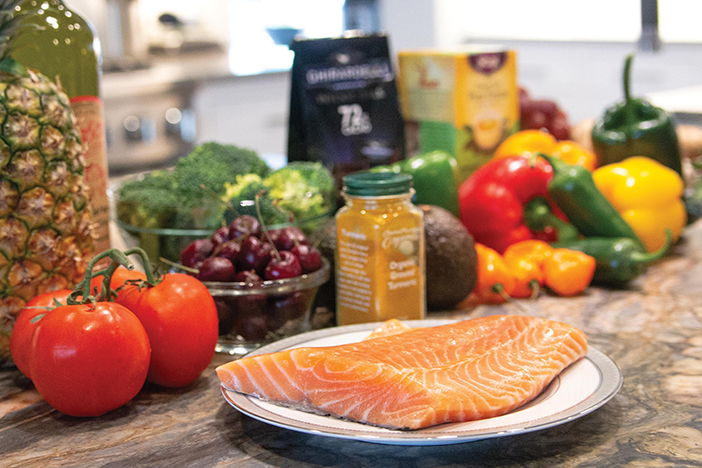Creating an Anti-Inflammatory Diet

Chronic inflammation has become an issue in our American culture. Between convenient processed foods, a sedentary lifestyle and high stress, it’s no wonder we’re dealing with heart disease, diabetes, fatty liver disease and cancers. Fortunately, we can combat inflammation, both short-term and chronic, with information and thoughtful nutrition.
What is inflammation? Inflammation is the body’s way of protecting itself from injury, illness and infection. It increases the white blood cell count, which are the immune cells, and a substance called cytokines to fight off infection. The issue with chronic inflammation is there isn’t illness to combat. The body is fighting a lifestyle.
One of the best ways to contend with inflammation is to increase the amount of anti-inflammatory foods into a daily nutrition plan. This allows the body to heal from the inside, using food as a primary source of treatment. Since many times it is food that initially causes the inflammation, understanding how different foods work in the body and how they can heal or harm gives a huge advantage in choosing the best items to include in a daily nutrition plan.
The first big step would be to increase the daily intake of vegetables like broccoli, mushrooms, brussels sprouts, spinach, kale, cauliflower, zucchini, asparagus and cabbage. These high fibrous, nutrient dense foods help to clean out the intestines, heal the gut and bring a variety of vitamins and minerals back into the body. Then, add fruits such as fresh berries, cherries, pineapple and grapes in place of sweets or other processed treats. Rich in antioxidants, which may help reduce the risk of disease and boost the immune system, these fruits will help to heal and curb the sweet tooth.
Look at your fats and switch out processed seed and vegetable oils for fresh avocado slices, olives, extra virgin olive oil, coconut oil and other healthy fats. The monounsaturated fats help reduce the risk of heart disease, brain cancer and other illnesses. Eat more fatty fish like salmon and mackerel that are packed with omega-3 fatty acids, EPA and DHA. Snack on nuts like almonds, walnuts, pecans and cashews. These delicious little bites provide great anti-inflammatory fats along with fiber and protein.
Drink green tea over coffee when possible. The antioxidant and anti-inflammatory properties in green tea are shown to reduce the risk of Alzheimer’s, heart disease and obesity. Season your foods with spices like turmeric, cinnamon and fenugreek. Not only will these seasonings enhance the flavors of your fresh vegetables and lean proteins, but they also help reduce inflammation and, in the case of cinnamon, help speed up your metabolism. Jalapeño and other hot peppers, as well as sweet bell peppers are packed full of vitamin C and antioxidants, leading to a reduction in inflammation and potentially healthier aging.
End your day with a piece of 70 percent dark chocolate. Dark chocolate is a rich, satisfying antioxidant-packed treat that lends to healthy aging and the reduction of chronic disease. Pair this desert with some fresh strawberries and almonds for a sweet and satisfying disease-fighting power punch.
When incorporating anti-inflammatory foods, it is also good to know which foods to limit or avoid. Sugary beverages, from soda to fruit juice to frappuccinos, provide no nutritional value and spike your insulin levels. Processed snack foods, like chips and crackers, and desserts like cake, ice cream and cookies should be saved for special occasions, not a daily menu option. Pastas, breads and other refined carbohydrates that have lost their natural fibers, vitamins and minerals in processing; packaged/processed meats like hot dogs, sausage and bologna need to be eaten with caution and care (not only for inflammation but for nitrates and other additives).
The goal in adapting any lifestyle, including an anti-inflammatory one, is to find a rhythm and balance. If you do not like a particular food, find another that does the same job in your body. The idea isn’t to suffer in your food — it is to thrive in your healthy body. Get creative, check out recipes or simply incorporate more whole fresh foods into your repertoire. Both your body and taste buds will thank you.
What could an anti-inflammatory day look like for nutrition?
Breakfast:
½ cup fresh berries
Egg white omelet with mushrooms, bell peppers and spinach
½ medium avocado
Lunch:
3-ounce salmon seasoned with dill
1 cup roasted brussels sprouts with balsamic vinegar and rosemary
1 tsp extra virgin olive oil/squeeze of lemon for dressing
2 cups arugula salad with tomatoes, cucumber, celery and carrots
3-ounce red potato
Snack:
1 medium apple, sliced and sprinkled with cinnamon
2 tsp cashew butter
Dinner:
4-ounce seared tuna
½ cup quinoa
2 cups kale, 1 tablespoon goat cheese, 1 tablespoon slivered almonds, 2 sliced strawberries, lemon and olive oil
1 cup zucchini slices
Dessert:
1 ounce 70 percent dark chocolate
1/3 cup fresh raspberries
28 grams walnuts






